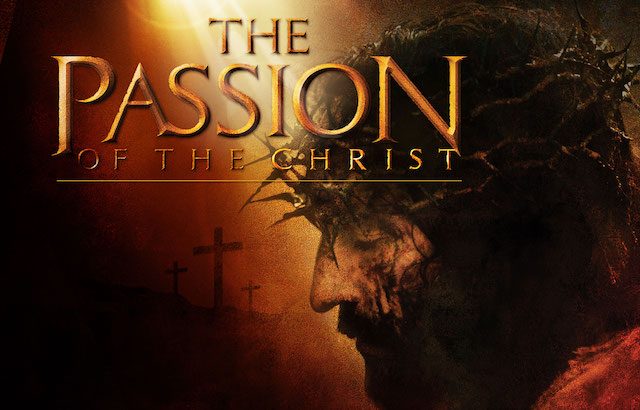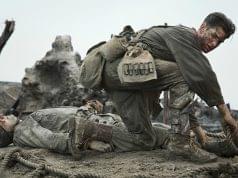
Between The Passion of the Christ and Fahrenheit 9/11, you’d have a hard time saying which 2004 movie was the most divisive and controversial, and which one depended the most on the beliefs that audiences brought with them to the theater. In what was otherwise a fairly calm year for cinema, these two kept critics a-talkin’ and pundits a-jabberin’ for months.
We’ll leave Michael Moore for another day and get to work on Mel Gibson. (Yeesh, these two, am I right??) The Passion of the Christ was an extraordinary event regardless of whether anyone liked it. Gibson had the actors speak Aramaic, Hebrew, and Latin, which was almost unheard of, and he focused on the physical torment Jesus suffered, earning a hard R rating where most movies on this subject had been tame family affairs (and in English). Thanks in large part to support from church groups, the film made $370 million in the U.S. and another $241 million overseas. It remains the highest-grossing R-rated movie of all time by a wide margin, and it holds the record for best February opening weekend ($83.8 million). Oh, and it was an independent film, too, produced by Gibson’s company Icon Productions and distributed by Newmarket.
What I said then:
“If there were an extraordinarily powerful six-hour miniseries about the life of Jesus, The Passion of the Christ would be the gripping two-hour finale…. The film begins in climax and remains in crescendo for two hours — a gripping way to tell any story, but especially a story as emotionally weighted as this one. I was enthralled from beginning to end, despite knowing the plot already and despite some scenes being unendurable for their graphic depictions of torture. I don’t believe anyone has made a movie about Jesus that is more compelling than this one, and certainly no film released so far this year [note: it was only February] has even approached this level of artistic quality…. Gibson stays faithful to his source material, but embellishes on it enough to give the narrative some structure and weight…. Gibson and I may disagree on some points of doctrine, but I respect anyone who makes a film based on his personal convictions, and even more so if the filmmaker does a vigorous, handsome job of it, as Gibson has done here…. [It is] a work of art that succeeds as a film, as a message, and, yes, as a labor of love.” Grade: A [complete review]
The reviews at the time were split almost equally between positive and negative at Rotten Tomatoes. The movie made it to my top 10 list for the year; it also appeared on some critics’ 10 worst lists. In my top 10 article, I wrote: “More than any film I’ve ever seen, it is subject to so much of the viewer’s personal baggage that reviewing it is nearly impossible. All I can do is say what it did to me, which is that it horrified, uplifted and compelled me — compelled me to keep watching (even when it was difficult), compelled me to think about my own beliefs in God, compelled me to ponder the film long after I’d seen it. Oh, and the filmmaking is pretty fantastic, too.”
The re-viewing:
I had to brace myself for this one. I remembered it as being brutally graphic and painful to watch. So I got good and drunk first.
No, I kid. I remained sober (which is probably more than you can say for Mel Gibson when he was making it). I recalled something Roger Ebert wrote in his review: “The movie is 126 minutes long, and I would guess that at least 100 of those minutes, maybe more, are concerned specifically and graphically with the details of the torture and death of Jesus.” OK, I thought, pressing “play.” Here goes!
An interesting fact: Ebert was way off in his assessment. Apart from Jesus getting manhandled and pushed around a bit, the physical torment doesn’t begin until minute 53, when the movie is nearly half over. Yet Ebert remembered the movie as being almost all pain, all the time — and so did I. The impression I had when I finished watching it in 2004 was that I’d just endured almost two solid hours of brutal violence. But it’s actually more like 45 minutes.
This became clear on the second viewing. The scourging scene remains gruesome and horrific. Some people used to die from that punishment alone, before they even got to the cross, and you can see why: jagged bits of bone and metal tied to the ends of the whips, gouging into the victim’s flesh, tearing out chunks — bleh. Bleh, I say! NO THANKS ON THE SCOURGING! In comparison, the crucifixion sequence was far less painful to watch, and those two sequences account for almost all of the violence and physical suffering depicted in the film.
So why did I remember it as being wall-to-wall torture? Two reasons. One is simply that the brutality is all in the second half, so it’s freshest in your mind when you leave the theater. The bigger reason, I think, is that even before the assault begins, Gibson does an excellent job of filling us with dread. We know it’s going to happen — not just because we know the story but because of the tense, ominous atmosphere created by the film. Jesus is already suffering spiritually when we begin, and the Jewish leaders are conspiring with Judas to arrest him. We get tense as we feel the storm clouds gathering, even before anything actually happens.
I said in my original review that allegations that the film was anti-Semitic were “wholly without merit. Jewish leaders are indeed shown to be the ones clamoring for Jesus’ execution, but there is no underscoring, no statements to the effect of, ‘Hey, look what THE JEWS did!'”
Since then, Mel Gibson has said a few things in public that would tend to, shall we say, bolster the argument that he hates the Jews, so I was on high alert as I watched it this second time, to see what I might have missed originally.
And I still don’t see it. If I didn’t know what I do about Gibson’s real-life behavior, I’d be baffled that anyone would even think Passion of the Christ is anti-Semitic. Katha Pollitt wrote in The Nation that “physically, they are anti-Semitic cartoons: The priests have big noses and gnarly faces, lumpish bodies, yellow teeth; Herod Antipas and his court are a bizarre collection of oily-haired, epicene perverts.” She’s partly right. Some of the Jewish priests in the film do have big noses and gnarly faces — but so do many of the people in the crowd scenes. The movie was shot in Italy, where big noses and gnarly faces are to be found in abundance, and the extras were cast because they looked authentic (i.e., ugly), not like movie stars. I don’t think the priests’ teeth were yellow, but I did notice poor dental hygiene, not to mention savage cruelty, on the part of the Roman soldiers scourging Jesus. Herod and his cohorts are indeed a bunch of hard-partyin’ freaks, but they’re the only ones in the movie like that, and there’s certainly no suggestion that their Jewishness has anything to do with it.
Nonetheless, not being Jewish, I acknowledge that I might not be as sensitively attuned to such things as someone who is. I guess all I can say is that The Passion of the Christ doesn’t seem anti-Semitic to me, and that I’ve seen it twice now and still like Jewish people. So if it was supposed to be anti-Semitic, it didn’t work. (Let me also be clear that anyone who uses the Bible as an excuse to persecute the Jews is an ignorant buffoon and a disgrace to Christianity.)
Something that didn’t work for me this time that apparently didn’t bother me in 2004 is the bald albino Satan figure who pops up occasionally and is once seen carrying a demon-faced child (or possibly a dwarf). Given that the rest of the film sticks mostly to the Biblical account and tradition, this seems like a bizarre place to take artistic license, not to mention a bizarre way to do it.
Do I still love this movie?
“Love” probably isn’t the right word for a movie as grueling as this one, but pretty much, yeah. While it isn’t as emotionally harrowing the second time around, and the extra-Biblical oddness is distracting, it’s a beautifully photographed and well-constructed movie. Many expressions of faith are sincere but artistically mediocre, but this one combines earnest religious sentiment with genuine skill. Grade: B+
— Film.com




